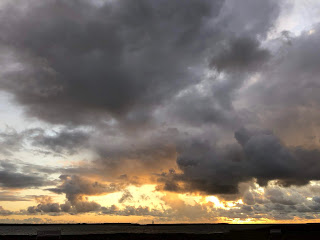 |
We normally move on each day during this trip but there have been occasions when we have liked somewhere so much that we have decided to stay a bit longer. Some of those places have been big cities like Stockholm and Copenhagen, others have been much smaller places like the Knuten trailhead near the village of Mefjord on the island of Senja in Norway, where we had space to walk and time to have a clean of the van. The latest place to take our fancy has been the Estonian seaside town of Haapsalu where we are spending our second night on an almost deserted car park looking across to the Baltic Sea.
 |
| Old Pyotr Ilyich could knock out a good tune |
Haapsalu has a lovely old town its narrow streets lined with early 20th century houses. It also has real history as the seat of the Prince Bishops of Ösel-Wiek who ran the area for 300 years from the 13th century. There was another boost to the economy in 1825 when a military doctor found that the local sea mud had a curative effect. This news quickly reached St Petersburg and the Russian aristocracy, including Czar Alexander II and his family, descended on the town to have their aches and pains sorted out. Such was the demand that a railway was built which ran all the way to Russia, so the nobles could travel in some style.
 |
| The Prince Bishops were at home here |
The town's pride and joy is the episcopal castle, begun in the 13th century as the seat of the Bishopric. The bishops held complete power much like our own Prince Bishops in Durham, and owed loyalty to the Holy Roman Emperor. It's a miracle that any of the castle has survived the turbulent periods of Estonian history. Peter the Great's forces destroyed part of the building in the 18th century and there have been a number of fires over the years. The cathedral within the castle walls was badly damaged by occupying Soviet troops during WWII. When Estonia finally shook off decades of Russian rule in 1991, a programme of restoration was started and huge amounts of money have been spent on both castle and cathedral which now presents a fascinating record of Estonian history.
 |
| It's amazing that any of the castle survived |
We were struck by the fact that Estonia, which so long suffered under Russian domination, first from the Czars and then from the Communists, never considered it was anything other than an independent country throughout these periods. The information in the castle just refers to the 'restoration of democracy' rather than the birth of a new nation. They also pull no punches when referring to the Russians, particularly during the communist period, describing those who damaged the cathedral in the 1940s as 'hooligans'. Little wonder that our guidebook says that relations between Estonia and its former conquerors remain 'cold'.
 |
| Kite surfers riding the elements |
Before we left the forest site yesterday we spent some time sticking flags and symbols of
 |
| A little decoration for Florence's rear |
 |
| Build your own Gothic arch in the castle |
 |
| Baltic sunset |

I’m really enjoying the history bites. Florence’s rear is looking very colourful, I do like the Norwegian stickers.
ReplyDelete